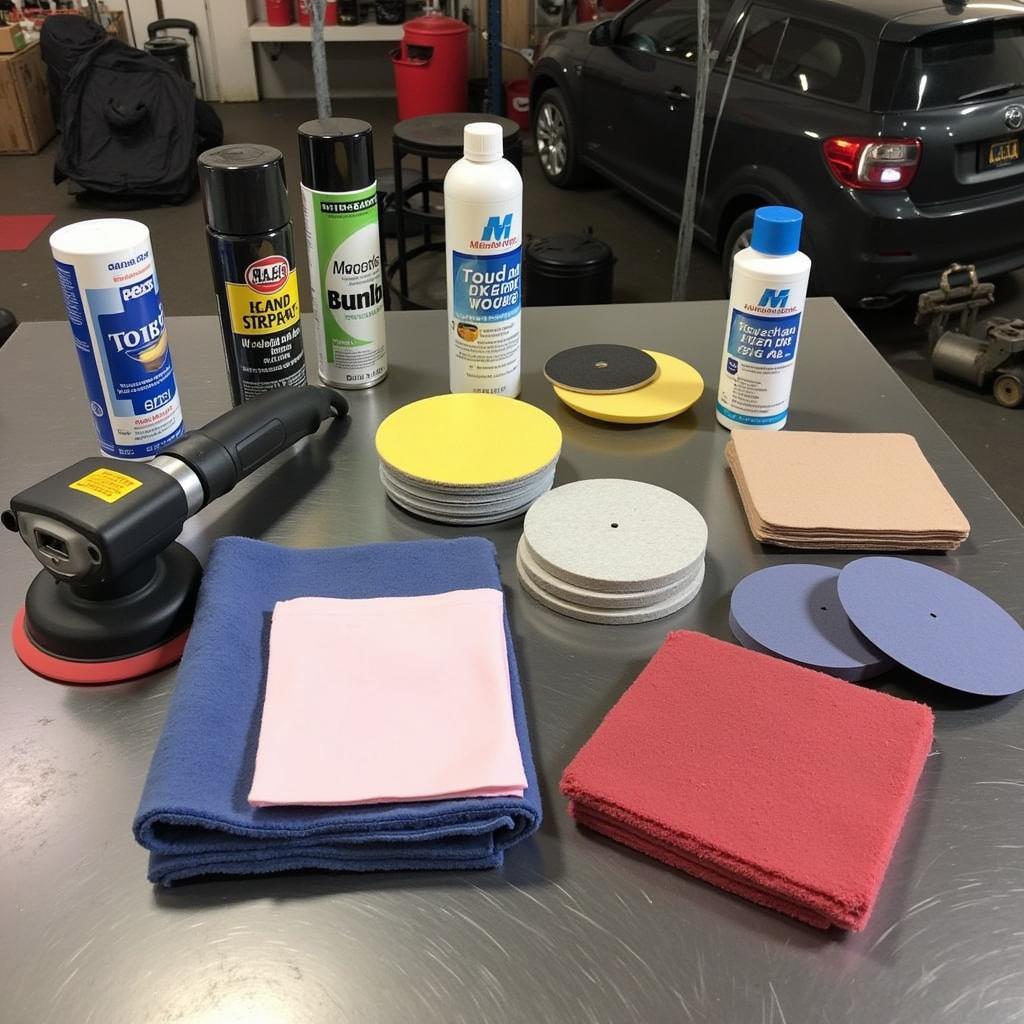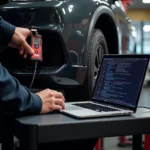Maintaining your car’s pristine appearance isn’t just about aesthetics; it’s about protecting your investment. A damaged top coat exposes the underlying paint layers to the elements, leading to fading, oxidation, and eventually, rust. Learning how to repair top coat on car paint yourself can save you significant money and keep your vehicle looking its best. Let’s dive into the essential steps and techniques for a successful DIY repair.
Identifying the Damage: Assessing Your Car’s Top Coat
Before embarking on the repair process, it’s crucial to determine the extent of the damage. Is it a minor scratch, a swirl mark, or a more significant chip? Different levels of damage require different approaches. Minor scratches and swirl marks often only affect the top layer of the clear coat and can be addressed with polishing compounds. Deeper scratches that penetrate the color coat require more involved repairs, possibly involving touch-up paint and clear coat application. For more serious damage, you might need professional help. car paint top coat repair.
What are the common signs of top coat damage?
Common signs include visible scratches, swirl marks, dullness, and chipped areas. In some cases, you may even see the underlying color coat exposed.
Gathering Your Supplies: The Right Tools for the Job
A successful top coat repair requires the right tools. Gather the following before starting: washing supplies, including car wash soap and microfiber towels, polishing compound, rubbing compound (if needed), applicator pads, masking tape, sandpaper (various grits, if needed), touch-up paint (if needed), clear coat (if needed), and a buffer (optional but recommended). Having everything at hand streamlines the process.
Can I use household cleaning products to wash my car before the repair?
No, household cleaners can strip away wax and potentially harm the clear coat. Always use a dedicated car wash soap.
Step-by-Step Guide: How to Repair Scratched Top Coat on Car Paint
- Wash and Dry: Thoroughly wash and dry your car to remove any dirt or debris that could further scratch the paint during the repair process.
- Assess the Damage: Identify the type and severity of the scratches. This will determine the appropriate repair method. how to repair scratched top coat on car paint.
- Polish (Minor Scratches): Apply a small amount of polishing compound to an applicator pad and work it into the affected area using circular motions. Gradually reduce pressure as the scratches disappear.
- Rubbing Compound (Deeper Scratches): For deeper scratches that the polishing compound doesn’t remove, use a rubbing compound followed by polishing compound. Be careful not to rub too aggressively, as this could damage the paint.
- Touch-Up Paint (Chips): If the scratch has penetrated the color coat, apply touch-up paint carefully using a fine-tipped brush. Allow the paint to dry completely.
- Clear Coat Application (Chips): After the touch-up paint has dried, apply a thin layer of clear coat over the area. Multiple thin coats are better than one thick coat.
- Wet Sanding and Buffing (Optional): If necessary, wet sand the repaired area with fine-grit sandpaper followed by buffing to blend the repair seamlessly with the surrounding paint.
Why is it important to repair top coat damage promptly?
Ignoring even minor damage can lead to more serious problems like rust and paint fading. A timely repair preserves your car’s finish and value.
Preventing Future Damage: Protecting Your Car’s Top Coat
Regular washing and waxing are essential for maintaining the integrity of your car’s top coat. Avoid using abrasive cleaners or brushes. Park in shaded areas whenever possible to minimize sun exposure. Consider using a car cover for added protection. For videos that can guide you, see youtube paint and repair car. Rust can be a real problem, so check out rust on car paint repair. Fender damage? We’ve got you covered: how to repair paint scrap on car fender.
Conclusion: Maintaining a Flawless Finish
Learning how to repair top coat on car paint is a valuable skill for any car owner. By following these steps and using the right techniques, you can effectively address minor paint damage and keep your car looking its best. Remember to always prioritize proper car care and address any damage promptly to prevent further deterioration.
FAQs
- How often should I wax my car? Every three to six months.
- Can I use any type of polishing compound? No, use a compound specifically designed for car paint.
- What grit sandpaper should I use for wet sanding? Start with 2000-grit and progress to finer grits if needed.
- How long should I wait before waxing after a repair? At least 24 hours.
- Can I repair deep scratches myself? It depends on the depth. Very deep scratches may require professional attention.
- What if the damage is on a plastic bumper? Similar techniques apply, but use products specifically designed for plastic.
- Where can I find matching touch-up paint for my car? Your car’s owner’s manual or a dealership can help.
Need more help? Check out these other articles:
- Car Paint Top Coat Repair
- How to Repair Scratched Top Coat on Car Paint
- Rust on Car Paint Repair
Need professional assistance? Contact us via WhatsApp: +1(641)206-8880, or Email: [email protected]. Our 24/7 customer support team is ready to help.



